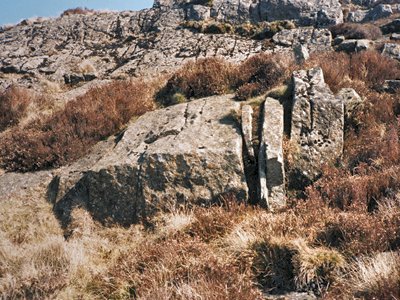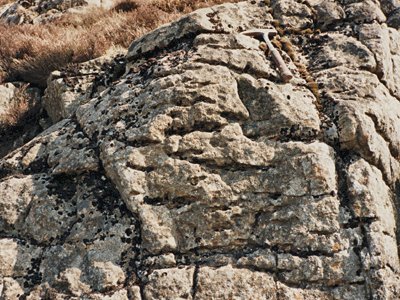Earth Science Conservation Review
| Slemish Mountain | Antrim |
| Site Type: | Crag, Crags, Inland exposure |
| Site Status: | ESCR |
| Council area: | Ballymena District Council |
| Grid Reference: | D22150540 |
| Google maps: | 54.88183,-6.09752 |
| Rocks | |
|---|---|
| Rock Age: | Tertiary (Eocene, Palaeocene) |
| Rock Name: | Antrim Lava Group, Upper Basalt Formation |
| Rock Type: | Dolerite, Porcellanite |
| Interest | |
| Minerals: | Olivine, Spinel |
| Other interest: | lava lake, multiple intrusion, plug, xenocrysts, Intrusion, Sheep grazing |
Summary of site:
Slemish Mountain is the dominant feature of the high ground around Douglas Top about 10km east of Ballymena and is famous for its supposed historic connection with Saint Patrick.
It is a volcanic plug, the main feeder conduit at the root of a volcano now stripped away by millions of years of erosion. It forced its way through earlier basalts which were slightly altered in the process by the intense heat. Its oval cross section is 790m long and 270m wide and filled with olivine dolerite, a medium-grained rock of basaltic composition. Dykes (cross-cutting intrusions) radiate from the conduit and were originally filled with molten rock in the volcano's active phase.
There is evidence of at least three periods of activity. Two early dolerites fill the outer part of the plug and, although they can not be separated by direct observation, they are easily differentiated by their chemistry, the later dolerite being richer in the mineral olivine. A third intrusion broke through the earlier two and spread to fill the conduit above and has a flat contact with them. Rafts of a finer-grained dolerite (thought to be fragments of solidified crust in the crater) settled through the molten lava on to the contact with the first two. These rafts (called xenoliths) and the layered nature of the earlier activity suggest that the rocks we now see on Slemish were not far below the surface of the Tertiary volcanic landscape.
Slemish is a fine example of a volcanic plug that preserves evidence of late-stage processes within the vent, just before the volcano became extinct. It forms a dramatic landscape feature with cultural associations.
BBC Northern Ireland web site - LANDSCAPES UNLOCKED www.bbc.co.uk/northernireland/landscapes/lev1_slemish_script.shtml
It is a volcanic plug, the main feeder conduit at the root of a volcano now stripped away by millions of years of erosion. It forced its way through earlier basalts which were slightly altered in the process by the intense heat. Its oval cross section is 790m long and 270m wide and filled with olivine dolerite, a medium-grained rock of basaltic composition. Dykes (cross-cutting intrusions) radiate from the conduit and were originally filled with molten rock in the volcano's active phase.
There is evidence of at least three periods of activity. Two early dolerites fill the outer part of the plug and, although they can not be separated by direct observation, they are easily differentiated by their chemistry, the later dolerite being richer in the mineral olivine. A third intrusion broke through the earlier two and spread to fill the conduit above and has a flat contact with them. Rafts of a finer-grained dolerite (thought to be fragments of solidified crust in the crater) settled through the molten lava on to the contact with the first two. These rafts (called xenoliths) and the layered nature of the earlier activity suggest that the rocks we now see on Slemish were not far below the surface of the Tertiary volcanic landscape.
Slemish is a fine example of a volcanic plug that preserves evidence of late-stage processes within the vent, just before the volcano became extinct. It forms a dramatic landscape feature with cultural associations.
BBC Northern Ireland web site - LANDSCAPES UNLOCKED www.bbc.co.uk/northernireland/landscapes/lev1_slemish_script.shtml
| Enlander, I., Dempster, M. & Doughty, P., 2025. Slemish Mountain, County Antrim, site summary. [In] Earth Science Conservation Review. https://www.habitas.org.uk/escr/summary.php?item=1116. Accessed on 2025-04-03 |
| Previous Site | Next Site |


